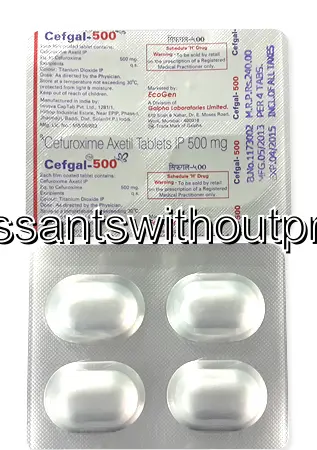| Package | Dosage | Price | Price per Dose | |
|---|---|---|---|---|
| Dosage: 125mg | ||||
| 90 pill | 125mg | $489.65 | $5.44 | |
| 60 pill | 125mg | $323.77 | $5.41 | |
| 30 pill | 125mg | $189.79 | $6.30 | |
| 10 pill | 125mg | $65.38 | $6.51 | |
| Dosage: 250mg | ||||
| 92 pill | 250mg | $689.02 | $7.50 | |
| 60 pill | 250mg | $456.15 | $7.61 | |
| 32 pill | 250mg | $287.08 | $8.95 | |
| 12 pill | 250mg | $114.82 | $9.57 | |
| Dosage: 500mg | ||||
| 60 pill | 500mg | $757.61 | $12.63 | |
| 32 pill | 500mg | $468.91 | $14.67 | |
| 24 pill | 500mg | $387.57 | $16.13 | |
| 12 pill | 500mg | $204.14 | $16.95 | |

Cefuroxime Description
Understanding Cefuroxime: An Overview
Cefuroxime is a broad-spectrum antibiotic widely used to treat a variety of bacterial infections. It belongs to the cephalosporin class of antibiotics, which work by disrupting the formation of bacterial cell walls. This interference ultimately leads to the destruction of harmful bacteria, helping the body eliminate the infection. Cefuroxime is often prescribed for respiratory tract infections, urinary tract infections, skin infections, and other bacterial conditions. Its effectiveness and safety profile make it a common choice for many healthcare providers.
Mechanism of Action and Effectiveness
This medication targets specific enzymes involved in bacterial cell wall synthesis. By inhibiting these enzymes, cefuroxime prevents bacteria from developing a stable cell wall, causing them to rupture and die. It is particularly effective against bacteria such as Haemophilus influenzae, Streptococcus pneumoniae, and certain strains of Staphylococcus. The drug's broad activity makes it suitable for treating mixed infections and those caused by resistant bacteria. Patients often experience relief from symptoms within a few days of starting therapy, although the full course must be completed to prevent antibiotic resistance.
Administration and Dosage
Cefuroxime is usually administered orally in tablet or liquid form, but it can also be given via injection in clinical settings. The dosage depends on the severity of the infection, the patient's age, weight, and kidney function. It is important to follow the prescribed dosage instructions carefully. Typically, courses last between 5 to 14 days, and skipping doses can reduce effectiveness or promote resistance. Taking the medication with food may help reduce gastrointestinal discomfort, a common side effect.
Possible Side Effects and Precautions
Like all medications, cefuroxime may cause side effects in some individuals. Common reactions include nausea, diarrhea, stomach pain, and skin rash. Serious allergic reactions are rare but require immediate medical attention. Patients with a known allergy to cephalosporins or penicillin should avoid cefuroxime. Additionally, it is important to inform healthcare providers if there's a history of gastrointestinal issues, as antibiotic-associated diarrhea can occasionally be severe. Long-term use can lead to overgrowth of resistant bacteria or fungal infections, so healthcare supervision is essential during extended treatment.
Drug Interactions and Considerations
Cefuroxime may interact with other medications, including blood thinners like warfarin. These interactions can increase bleeding risk or alter drug effectiveness. It is crucial to inform the prescribing doctor about all current medications and supplements. Patients with kidney impairment may require dosage adjustments to prevent accumulation and toxicity. Pregnant and breastfeeding women should consult their healthcare provider, as safety data is limited. Overall, adherence to the medical advice ensures the safe and effective use of cefuroxime.
